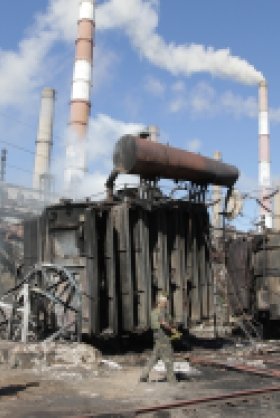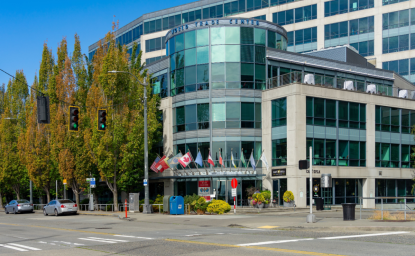Kennan Cable No. 36: On the Edge: War and Industrial Crisis in Luhansk Oblast


Luhansk Oblast was already a troubled rust belt region when 80 percent of its urban territory was seized by Russian and separatist forces in 2014. For the past four years the foundation of the industrial economy in the oblast’s government-controlled areas (GCA) has been steadily eroded by the armed conflict and accompanying trade war with Russia.
Industrial exports from Luhansk Oblast are at 6 percent of 2013 levels. Coal production dropped to a third of pre-war volume and steel production to an eighth. For the first three years of the war some mines and factories in the separatist-held territories continued paying taxes to Kyiv and exporting their products through Ukraine, but this fragile economic tie was abruptly snapped in 2017 when Kyiv backed an unofficial trade blockade by Ukrainian army veterans.[1] In retaliation, the separatist authorities “nationalized” all remaining enterprises.
Severed economic ties within the country and between Ukraine and Russia have idled all three of the factories that provided three-quarters of pre-war GDP in the oblast. In separatist-controlled Alchevsk the largest metallurgy plant in Europe is cut off from global markets and is operating at a fraction of capacity. In the GCA the Severodonetsk Azot chemical plant and Lisichansk oil refinery are barely operable after the flow of Russian oil and gas dried up.
Even if these huge idled factories in the GCA returned to production the province’s electricity system could not support them. Today the oblast is powered by a single war-damaged power plant located directly on the front line, and the power company is so overloaded with debt it is not clear it can keep the lights on for the oblast’s residents.
Conditions in the GCA are dire. The situation is, however, much worse in the half of the province under separatist control, the so-called “Luhansk People’s Republic.” Even sympathetic observers such as the pro-separatist journalist Sergey Sakadinsky[2] note the dim prospects for reviving factories and mines in the occupied territories due to economic isolation, war damage, mismanagement by the new owners, and widespread marauding.
But the GCA of Luhanska Province is falling drastically short of becoming the showcase of economic recovery that the government would like it to be, and for this Kyiv deserves its share of the blame. The Ukrainian government has no strategy commensurate to the scale of the crisis, and a diverse range of policies have made it even worse.
There are bright spots in this bleak picture, such as dynamic small manufacturers who have adapted to the wartime economic conditions. But they should not be left to deal with the profound crisis alone.
Severodonetsk: Severed Ties
Before the war the Severodonetsk Azot fertilizer plant was as a cog in the hugely profitable natural gas empire of oligarch Dmytro Firtash. But today Firtash is hiding out from American and Ukrainian authorities in Vienna and his Russian gas contracts are in tatters. The Ukrainian chemical fertilizer industry that he nearly monopolized is teetering on the edge of collapse.
The shuttering of the Azot plant casts a deep pall over Severodonetsk,[3] which is the new capital of Luhansk Province while the region’s namesake city is under occupation. Residents of the “City of Chemists” fear they are on a death watch for the plant and anxiously monitor for the trucks full of metalolom (scrap metal) that have marked the end of so many Donbas factories.
Valeriy Chernish, the head of the factory’s labor union, has seen hundreds of engineers and laborers leave Severodonetsk, mostly for chemical plants in Russia and Kazakhstan or simply as part of Ukraine’s enormous low-skilled labor migration. He told me that he worries the outflow of specialists has been so extensive that it may not be possible to restart production if conditions improve.[4]
The fate of Severodonetsk Azot and its 7,000 jobs largely hinges on which side Kyiv picks between competing economic and political interests.[5] On one side is the chemical industry clamoring for protective tariffs against Russian fertilizers made with subsidized natural gas. On the other are farmers who hunger for cheap fertilizer, even if it comes from the aggressor to the east. For four years Kyiv has vacillated between them, managing to cause instability for both farmers and industry, lost crop production, and shut downs and layoffs at Severodonetsk Azot.
In 2018 Prime Minister Groysman came down firmly on the side of industry, with heavy tariffs,[6] though Russia has since won a case before the World Trade Organization to have them struck down.[7] But in the long run protectionism will not save chemical plants like Azot without an affordable replacement for Russian gas. Many experts call on Kyiv to direct subsidized gas from the state drilling and distribution firm Naftogaz, but others like liberal lawmaker Serhiy Leschenko decry[8] this as a subsidy to the oligarch Firtash. After all, he will likely use the resulting profits to pay back loans to Russian banks that financed his business empire. That thought disgusts Ukrainians who believed the 2014 Euromaidan revolution would lead to genuine “de-oligarchisation” of the economy.
Small is Beautiful
Industrial giants like Azot seek political solutions to their economic woes. But in Severodonetsk and neighboring Rubizhne small and mid-size manufacturers have no such luxury and must demonstrate a high level of flexibility and innovation to survive.[9] Many have proven themselves in these harsh conditions, such as the Tana Polymer company, which has opened two new manufacturing facilities in the shadow of Azot’s idle smokestacks since the start of the war. Tana has diversified beyond its pre-war client base in Russia, and director Aleksandr Litvinov proudly notes that today some of his polymer components end up in German Volkswagens.[10]
These small manufacturers offer a respite from the deep pessimism of the region. But many structural constraints must be addressed if they are to accelerate their growth and make up for the outflow of workers from dying giants like Azot. These barriers include the fact that Luhansk Oblast has Ukraine’s most expensive and unreliable electricity and its worst roads[11] and a near total lack of bank credit due to the uncertainty created by a front line just 30 kilometers way.
Lisichansk: Cradle to Grave?
Industrial collapse began well before the war in neighboring Lisichansk, which is nicknamed the “Cradle of the Donbas” because it hosted the first coal mines in the Russian Empire. The city’s plight shows the complexity of pre-war economic relations between the Ukrainian Donbas and Russia, which were a mixture of Soviet-era interdependence and bare-knuckle competition.
On the eve of the Euromaidan protests in 2013, Lisichansk saw angry protests over the shutdown of most of the city’s industrial employers.[12] The protestors blamed Russian oligarchs who, they claimed, bought up factories just to shut them down and reduce competition. For instance, the historic Lisichansk Soda Plant was literally blown up by a Chechen businessman who owned soda lime factories in Russia. Another sore spot was the Lisichansk oil refinery, bought by Rosneft in 2000 and operated for 10 years with Siberian crude but idled abruptly in 2012.
Anger was also directed at the ruling Party of Regions politicians like former governor Aleksander Efremov (currently on trial for separatism)[13] who allegedly drove factories into bankruptcy by forcing them to buy overpriced natural gas from utility monopolies and then seizing their assets to cover the resulting debts.
One journalist described the city as “on the edge of revolution.”[14] Interestingly, some of the most active protestors against Russian oligarchs and local pro-Russian politicians in Lisichansk were Communists, who just six months later would participate enthusiastically in the Russian-backed separatist uprising in the city, alongside Chechen mercenaries.
Today the only giant left stirring in the city is Lisichansk Coal, the state-owned firm left over after the most profitable mines were privatized in the 2000s and taken over by the separatists in 2014. One of the company’s four mines is operating normally, while in the others, “we’ve returned to the Stone Age,” as an engineer who preferred to remain anonymous explained. “We are getting the coal out with jackhammers like in the 1930s,” he said.
According to an analysis funded by USAID,[15] the production cost of getting a ton of coal out of the ground in Lisichansk is three times higher than the market price. Ukraine’s public mines are notoriously dependent on subsidies, and many wonder if Lisichansk Coal will be “optimized” by Kyiv: that is, shut down. Russia implemented just such an optimization in its part of the Donbas coal basin in the 2000s, and the social consequences are reverberating still, in miners’ protests and hunger strikes.[16] Such demonstrations are already commonplace in Lisichansk.[17]
One possible glint of hope for Lisichansk Coal could come if the government gives preference to power plants that switch from the anthracite coal mined in the separatist-held territories to brown coal, which is still found in abundance in government-controlled mines. This is clearly a question of national security: Russia has become the country of origin for 78 percent of Ukraine’s anthracite imports ever since Kyiv imposed the trade blockade on separatist-held territories in 2017.[18]
Attempts by the Cabinet of Ministers to mandate the transition to brown coal have been continuously held up by political maneuvering. The most recent attempt was blocked when Russian-owned energy distribution firms denied the national energy board the quorum needed to adopt the policy.[19] This exasperating situation clearly demonstrates how many levers of influence Russia still maintains over economic policy in Ukraine.
An attempt is being made to stave off the conversion of another historic factory to metalolom. Lisichansk city council member and war veteran Vitaliy Shvedov successfully appealed to Kyiv to cancel the contract under which the state-owned Proletariat Glassworks had been run into bankruptcy by powerful local politicians.[20] Today the glassworks is under crisis management by the Ministry of Economy and Trade, undergoing a thorough inventory in preparation for new managers.
Shvedov told me that the factory’s owner, the Ukrainian government, should make the first investment to help revive the plant.[21] This would contradict the neoliberal and austere zeitgeist in post-revolution Kyiv; the dismal record of subsidizing the unprofitable Lisichansk Coal is a cautionary tale. But with Lisichansk locked in an economic spiral, is Kyiv prepared to consider more direct measures?
Popasna: Waiting on Trains
When I first visited the small railroad city of Popasna in March 2015 its residents were just emerging from their basements and root cellars after four months of intense shelling. Entire city blocks were without windows and many apartment buildings and private homes had taken direct hits from heavy artillery.
Three years later Popasna is tidy and well repaired, but the outskirts of the city are still occasionally shelled. In May two members of a family of four were killed and two left in intensive care when a nearby village came under fire.[22]
So it is surprising that one of the few large enterprises still operating in the GCA is found in this front line city: the Popasna Railcar Repair Plant (PRRP).
Before the war PRRP was almost exclusively focused on the enormous Russian market, but in 2012 Russia imposed an import substitution policy and reduced purchases from Ukraine to a tenth of earlier levels. When Moscow launched its war in 2014 it cancelled the licenses for all Ukrainian railcar manufacturers that allowed their products on Russian railroads. This effectively shut them out of connected markets in the Commonwealth of Independent States as well.
PRRP’s director, Anatoliy Netiukhailo, was told by Russian officials, “we’d gladly license your factory if it was only in the Luhansk People’s Republic.” But Russian licenses did not help the Stakhanov Railway Car Building Works, 25 kilometers away in separatist-held territory. Today it is idled, like many factories that learned quickly that Russia would not liberalize trade with the “People’s Republics” in Luhansk and Donetsk.
When around 50 shells landed in and around the PRRP during the worst of the fighting in 2014–2015, its workforce shrunk from 2,300 to a core of 800 employees. “They saved our factory,” Netiukhailo told me at his office in Popasna.[23] The director left the gates of the factory open at all times if employees wanted to flee, but many got used to a cycle of assembly line/bomb shelter/assembly line.
Today PRRP employs 1,200 workers in a city of no more than 15,000 residents. The factory has re-oriented entirely to the domestic market and is working at full capacity on railcar repairs but only at one-third capacity for producing new cars. In the director’s words, “we need contracts from Ukrzaliznitsia [Ukrainian Railways] like oxygen.”
But the flow of contracts to PRRP and similar factories across Ukraine depends on Kyiv marshaling the political will and the money to upgrade Ukrzaliznitsia’s freight stock. Nearly one-third of Ukraine’s freight cars are stranded in Crimea and the occupied territories of the Donbas,[24] and by the railway’s own estimate around 90 percent of freight cars are on the edge of inoperability. The metallurgy industry and wheat farmers complain of dire transport bottlenecks that hold back production and export.[25]
After two years of dismally small purchases Ukrzaliznitsia put out several large orders for freight cars in 2017. PRRP produced 250 gondola cars for the national rail company and is presently fulfilling contracts for private shipping firms. Factory director Netiukhailo expresses guarded optimism about future state contracts and describes plans to enter the European market as a parts supplier.
But this promising new direction requires significant investment, and Popasna has even more of an uphill climb than Lisichansk in attracting bank credit or private investors. Netiukhailo points out that PRRP has adapted to extreme market conditions few competitors face (temporary occupation, shelling, and logistical near-collapse) and provides an economic lifeline to war-torn Popasna, but it receives no special attention from Kyiv in the form of preferences in contracting, subsidized loans, or development funding.
Schastia: Keeping the Lights On
Nowhere are the consequences of policy drift in Kyiv more visible than in Luhansk Oblast’s energy sector.
Electricity has been an expensive and rationed commodity since heavy fighting in 2014 knocked out the lines connecting the oblast to the national energy grid and seriously damaged the region’s only power plant in frontline Schastia.[26] The trade blockade imposed in 2017 deepened the crisis, since the plant is dependent on anthracite coal that is now legally inaccessible in the occupied territories.
Large factories like Azot and the Lisichansk oil refinery would easily swamp the power plant if they were to resume production. But four years into the crisis the authorities have still not finished erecting the single power line that would reconnect the oblast to the national grid through neighboring Kharkiv Oblast.
On top of this is one more layer of policy absurdity. The electricity produced in Schastia is sold to the government energy utility, which in turn sells it to the privatized Luhansk Energy Company (LEO) for distribution to households and businesses. In 2014 the Cabinet of Ministers forbade LEO from shutting off electricity to Luhansk and other occupied cities for humanitarian reasons but failed to offer any kind of compensation to the private company. LEO was able to collect only around 10 percent of payments for electricity in the occupied territories. The company soon found that even factories and mines with Ukrainian owners were shirking their payments, as well as water companies in the GCA that send water to Luhansk.
LEO director Volodymyr Hritsai describes this policy as “paying for communism in the Luhansk People’s Republic.” [27] Ukraine sent free electricity to the separatists, who in turn collected utility payments from the population. Soviet-style low utility prices have been one of the main propaganda points for the Luhansk People’s Republic, while electricity in the Luhansk GCA is now the most expensive in Ukraine.
After the imposition of the trade blockade in 2017 Kyiv finally cut off electricity to the occupied territories, which now get their power from Russia instead.[28] But despite multiple appeals, Kyiv failed to acknowledge that LEO’s plight was the direct result of state policy, and the company has racked up more than $200 million in debt to the government utility.[29]
Hritsai told me that the company has cut back all employees to a three-day work week, with many of them receiving less than minimum wage (around $134 a month). More than 700 workers have left LEO, and the difficult work of servicing Luhansk Oblast’s war-damaged grid is left to a demoralized and underpaid skeleton crew using safety equipment donated by the International Red Cross. They have taken to picketing the offices[30] and cutting off power to state water companies and factories in the GCA that are not paying their electricity bills.[31] This has led to the company being called a “terrorist”[32] by the oblast’s vice-governor.
It is inconceivable that the central government could ignore this festering policy disaster for so long in the most vulnerable and alienated corner of Ukraine.
Conclusion
Kyiv must address the structural problems undermining the Luhansk Oblast’s industrial base and should develop a realistic economic survival plan until a semblance of market normalcy returns.
The first step is to resolve the absurd, self-inflicted energy crisis by freezing the debts the oblast power company has accumulated as a result of non-payment in the occupied territories. The re-connection of Luhansk Oblast to the national grid should be accelerated, and the feasibility of switching the Schastia power plant from Russian anthracite to locally available brown coal should be seriously investigated.
In the longer term Kyiv should invest in diversifying the region’s energy production, taking advantage of material and technical assistance offered by countries like Denmark[33] to develop alternative energy. The Oblast could generate 25 percent of its electricity from agricultural waste alone.
The government should assemble a strategic investment fund to help compensate for the “red-lining” of Luhansk Oblast by most Ukrainian banks. This fund could offer credit at discounted interest rates and extended time frames to the small and mid-sized manufacturers that have demonstrated the greatest flexibility and potential for growth, but which are starved for liquidity. Many such enterprises claim that with credit available they could make investments needed to adapt to their new economic conditions and diversify their markets.[34]
But much more than money is needed, starting with a change in mentality. There is much talk in Ukraine about “de-politicizing” the economy and liberating market forces by zeroing out market-distorting subsidies and privatizing state firms. In many cases this approach is laudable, but it is not clear that laissez-faire is appropriate for a region experiencing profound economic shock and fundamentally unnatural market conditions.
If there was a genuine industrial strategy in place for the Donbas, a number of policies could be aligned to help support enterprises reeling under the pressure of war and economic collapse, including preference in state contracting (i.e., railcars in Popasna) or the provision of subsidized Ukrainian gas. At the very least such a strategy could hold off more “own goals” like the disastrous trade blockade or the electricity crisis.
Not every traditional industrial sector can be saved. But the residents of this war-torn region cannot be blamed for thinking that their government is not even trying. At least not yet.
[1] Christian Neef, “Little Russia. Pro-Russian Separatists Harden Split from Ukraine,” Spiegel Online, July 28, 2017, http://www.spiegel.de/international/world/little-russia-pro-russian-separatists-harden-split-from-ukraine-a-1159642.html.
[2] Aleksandr Chalenko, “Sergey Sakadinsky: The idea of Unification of Donetsk and Luhansk is Viewed Negatively by Luhansk Residents.” Ukraina.ru, August 9, 2017 (in Russian), https://ukraina.ru/exclusive/20170809/1019010921.html.
[3] Brian Milakovsky, “A Frontline Factory, an Embattled Oligarch and Ukraine’s Industrial Drift,” openDemocracy Russia, May 2, 2018, https://www.opendemocracy.net/od-russia/brian-milakovsky/a-frontline-factory.
[4] Personal interview, Valery Chernish, Severodonetsk, April 10, 2018.
[5] Brian Milakovsky, “A Frontline Factory, an Embattled Oligarch and Ukraine’s Industrial Drift,” openDemocracy Russia, May 2, 2018, https://www.opendemocracy.net/od-russia/brian-milakovsky/a-frontline-factory.
[6] “Cabinet of Ministers Forbids Import of Fertilizer from the Russian Federation,” Ukrainska Pravda, March 14, 2018 (in Ukrainian), https://www.pravda.com.ua/rus/news/2018/03/14/7174563/.
[7] “Ukraine in the Framework of the WTO Lost its Case Against Russia Regarding Fertilizer,” Kommersant, May 18, 2018 (in Russian), https://www.kommersant.ru/doc/3634312.
[8] “Parliamentarian: Tariffs on Fertilizer from the Russian Federation Allow Ostchem to Maintain Inflated Prices in the Ukrainian market,” RBC-Ukraine, June 12, 2017 (in Ukrainian), https://www.rbc.ua/ukr/news/rade-prosyat-proverit-zakonnost-antidempingovyh-1497251687.html.
[9] Oleksiy Vinohradov, “New Markets, Old Roads and Lack of Investment: How is the Free Industrial Region of Luhansk Living?” Radio Svoboda, June 11, 2018 (in Russian), https://www.radiosvoboda.org/a/donbass-realii/29284014.html.
[10] Personal interview, Aleksandr Litvinov, Severodonetsk, February 5, 2018.
[11] “Roads in Luhanska Oblast are the Worst in Ukraine,” Pervaya Polosa, August 19, 2018 (in Russian), http://1polosa.net/news/dorogi-v-luganskoy-oblasti-khudshie-v-ukraine/.
[12] Stanislav Kmyet, “The Reality of ‘Improvement.’ Lisichansk on the Edge of Revolution,” Ostro, June 13, 2013 (in Russian), https://www.ostro.org/general/politics/articles/420724/.
[13] Anastasia Vlasova, “Court Arrests Ex-Yanukovych Ally Suspected of Separatism for Two Months,” Kyiv Post, August 1, 2016, https://www.kyivpost.com/multimedia/photo/efremov-trial-420016.
[14] Stanislav Kmyet, “The Reality of ‘Improvement.’ Lisichansk on the Edge of Revolution,” Ostro, June 13, 2013 (in Russian), https://www.ostro.org/general/politics/articles/420724/.
[15] Taras Tkachuk, Roman Nitsovich, and Serhiy Lohvin, “’Black Holes’ of the Country: Why Subsidize State Mines,” Ekonomichna Pravda, January 10, 2018 (in Ukrainian), https://www.epravda.com.ua/rus/publications/2018/01/10/632715/.
[16] Anna Artemeva and Elena Kostiuchenko, “’We Aren’t Slaves, Aren’t Slaves!’ Gukovo Miners Refused ‘Hand Out’ from the Rostov Governor and Continue Their Hunger Strike,” Novaya Gazeta, August 25, 2016 (in Russian), https://www.novayagazeta.ru/articles/2016/08/25/69680-my-ne-raby-ne-raby.
[17] Vitalii Atanasov, “Undermined: How the State is Selling Out Ukraine’s Coal Workers,” openDemocracy Russia, December 19, 2016, https://www.opendemocracy.net/od-russia/vitalii-atanasov/faded-glory-ukraines-miners.
[18] “Almost 79 Percent of Ukraine’s Coal Imports in 2017 Came from Russia,” 112 International, April 12, 2018, https://112.international/finance/almost-79-percent-of-ukraines-anthracite-coal-imports-in-2017-came-from-russia-27534.html.
[19] Vitaliy Kulik, “Hybrid Anthracite: How Russia is Strengthening its Position in the Ukrainian Energy Sector,” Hvylya, June 1, 2018 (in Russian), http://hvylya.net/analytics/economics/gibridnyiy-antratsit-kak-rossiya-ukreplyaet-pozitsii-v-energetike-ukrainyi.html.
[20] “Lisichansk Glassworks ‘Proletariat’: The Latest Patient of Dunaev is Practically Dead,” Vostochniy Reporter, April 22, 2016 (in Russian), http://v-reporter.com.ua/lisichanskij-steklozavod-proletarij-ocherednoj-pacient-dunaeva-prakticheski-mertv.htm.
[21] Personal interview, Vitaliy Shvedov, Severodonetsk, June 15, 2018.
[22] Oksana Grytsenko, “Two Civilians Killed, Two Wounded Overnight by Shelling in Luhansk Oblast,” Kyiv Post, May 18, 2018, https://www.kyivpost.com/ukraine-politics/three-civilians-killed-overnight-shelling-luhansk-oblast.html.
[23] Personal interview, Anatoliy Netiukhailo, Popasna, July 8, 2018.
[24] “Ukrzaliznitsia Plans to Use its Own Facilities to Build Around 4,200 Freight Cars in 2018,” Interfax Ukraine, October 24, 2018 (in Russian), http://interfax.com.ua/news/economic/456949.html.
[25] “Critical Situation with Freight Cars of Ukrzaliznitsia is Hitting Metallurgy and the Hyrvnia Exchange Rate,” Sevodnya, October 13, 2017 (in Russian), https://www.segodnya.ua/economics/transport/kriticheskaya-situaciya-s-gruzovymi-vagonami-ukrzaliznyci-bet-po-metallurgam-i-po-kursu-grivni-1063858.html.
[26] “As a Result of Artillery Strike Luganskaya Power Station Partially Ceased Operation,” Vesti, October 8, 2014 (in Russian), https://vesti-ukr.com/donbass/72599-v-rezultate-artobstrela-luganskaja-tjes-chastichno-prekratila-rabotu.
[27] Volodymyr Hritsai, “Why Are Ukrainians Paying for Communism in the ‘LPR’ and a Few More Questions for the President,” Censor, June 8, 2018 (in Russian), https://censor.net.ua/blogs/3070415/pochemu_ukraintsy_oplachivayut_kommunizm_dlya_lnr_i_esche_neskolko_voprosov_k_prezidentu_ukrainy.
[28] Anna Trunina, “Electricity to Luhansk Cut Off,” RBC, April 25, 2018 (in Russian), https://www.rbc.ru/politics/25/04/2017/58fe7e5e9a79471d4bcc8113.
[29] Ibid.
[30] “LEO Started Picketing Debtor Enterprises,” Comments.ua, February 6, 2018 (in Russian), https://donbass.comments.ua/news/134853-leo-nachalo-piketi-predpriyatiy-dolzhnikov.html.
[31] “LEO Left More Than 47,000 Residents of Lisichansk and Borovskoe Without Water,” O6452.com.ua, April 23, 2018 (in Russian), https://www.06452.com.ua/news/2019750.
[32] Maryana Deikun, “Klimenko Called LEO Terrorists: The Reaction of the Energy Monopolist,” V Chas Pik, May 23, 2018 (in Russian), http://vchaspik.ua/region/445923-klimenko-nazval-leo-terroristami-poyavilas-reakciya-energokompanii-monopolista.
[33] Ukraine Denmark Energy Center, http://www.udec.org.ua/en/.
[34] Oleksiy Vinohradov, 2018.
Author


Kennan Institute
The Kennan Institute is the premier US center for advanced research on Eurasia and the oldest and largest regional program at the Woodrow Wilson International Center for Scholars. The Kennan Institute is committed to improving American understanding of Russia, Ukraine, Central Asia, the South Caucasus, and the surrounding region though research and exchange. Read more

Explore More
Browse Insights & Analysis
Seattle Debacle Presaged the End of the Road for Open Trade

Mexico’s Overhaul of its Antitrust Policy and Enforcement

